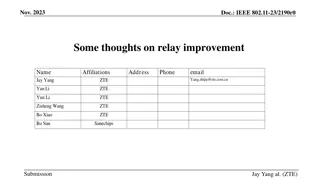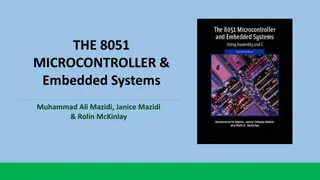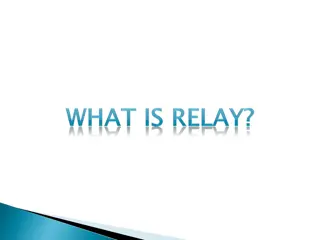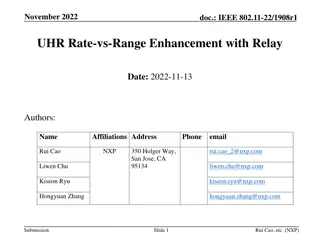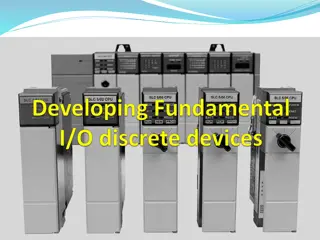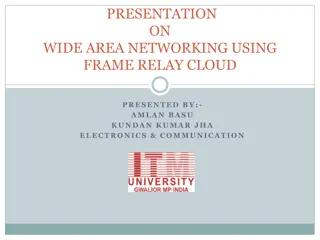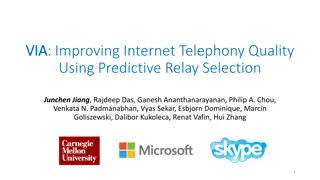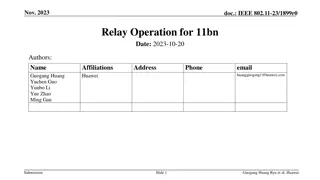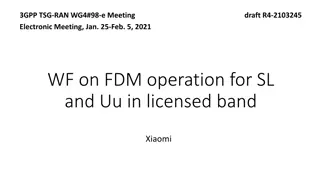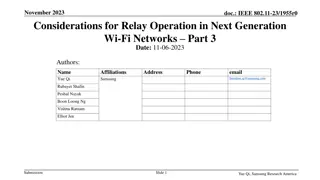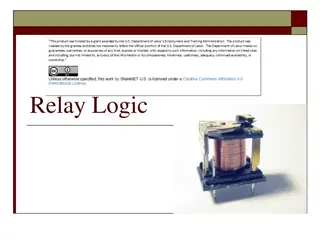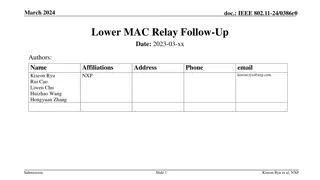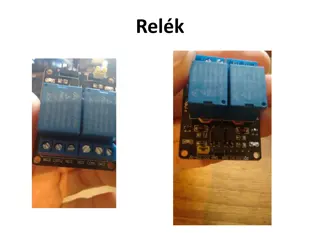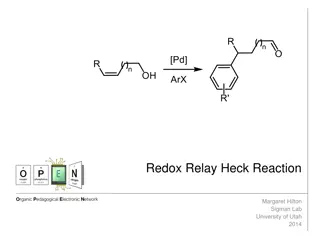Considerations for Relay Operation in Next Generation Wi-Fi Networks
In this document, considerations and use cases for relay operation in next generation Wi-Fi networks are discussed. The authors provide insights into the improvements in reliability and throughput, focusing on the benefits of relay features in various scenarios such as smart home devices and automotive communication. New use cases and technical directions are also deliberated upon to enhance network performance. Key topics include range extension, smart device connectivity, and user experience enhancement through relay operation.
Download Presentation

Please find below an Image/Link to download the presentation.
The content on the website is provided AS IS for your information and personal use only. It may not be sold, licensed, or shared on other websites without obtaining consent from the author. Download presentation by click this link. If you encounter any issues during the download, it is possible that the publisher has removed the file from their server.
E N D
Presentation Transcript
November 2023 doc.: IEEE 802.11-23/1928r0 Considerations for Relay Operation in Next Generation Wi-Fi Networks part 2 Date: 11-03-2023 Authors: Name Peshal Nayak Affiliations Samsung Address Phone email p.nayak@samsung.com Yue Qi Boon Loong Ng Rubayet Shafin Vishnu Ratnam Elliot Jen Submission Slide 1 Peshal Nayak, Samsung Research America
November 2023 doc.: IEEE 802.11-23/1928r0 Abstract In this presentation we provide some thoughts on use case consideration for relay operation. Submission Slide 2 Peshal Nayak, Samsung Research America
November 2023 doc.: IEEE 802.11-23/1928r0 Introduction To improve reliability and throughput, the UHR PAR document considers Rate-vs-Range (RvR) throughput improvement as one of the main objectives. Several contributions have considered relay as a candidate solution for range extension and discussed different aspects that need to be considered for relay feature development [1]-[5] In this contribution, we provide our views on use cases and some high level technical directions that can be considered for relay operation. Submission Slide 3 Peshal Nayak, Samsung Research America
November 2023 doc.: IEEE 802.11-23/1928r0 Relay Use Case Prior Work Prior contributions on relay have focused on a few use cases [1],[2]: Home networks where weak coverage areas/dead zones exist Communication in an automotive such as rear side smart device communication with dashboard Submission Slide 4 Peshal Nayak, Samsung Research America
November 2023 doc.: IEEE 802.11-23/1928r0 New Use Cases for Relay Operation In this contribution, we discuss two more factors that can be considered for relay use case discussion Submission Slide 5 Peshal Nayak, Samsung Research America
November 2023 doc.: IEEE 802.11-23/1928r0 Relay Use Case 1 In a home environment, there are a number of smart home devices that tend to be fixed in location. Wall mounted security devices such as surveillance cameras, wireless video doorbells, etc. Heavy smart home appliances that tend to be fixed in location. E.g., smart refrigerators, smart dishwashers, smart washers and dryers, etc. Smart home appliances that are located in specific areas for best user experience. E.g., smart home TV, wireless speakers, etc. Connectivity related issues are commonly encountered for such devices Relay operation can greatly benefit these applications and improve user experience. Submission Slide 6 Peshal Nayak, Samsung Research America
November 2023 doc.: IEEE 802.11-23/1928r0 Thoughts on Use Case 1 For this discussion, we can view the AP has having two types of coverage areas: Basic coverage area: Region where the AP can provide coverage on its own. Extended coverage area: Region where the AP can be thought of as providing coverage but with the help of the relay. Submission Slide 7 Peshal Nayak, Samsung Research America
November 2023 doc.: IEEE 802.11-23/1928r0 Thoughts on Use Case 1 Basic functionalities that are available within the basic coverage area: Discovery of AP Association with an AP Data transmission/reception to/from the AP For fixed devices, it can also be beneficial if the functionalities provided in the basic coverage area are also available in the extended coverage area. This can also be beneficial for devices that turn ON Wi-Fi in a dead/weak zone of the basic coverage area. To address this, in addition to relaying the STA s traffic, it can be beneficial if the relay can also provide some more functionalities: Relay assisted discovery of an AP Relay assisted association with an AP Slide 8 Submission Peshal Nayak, Samsung Research America
November 2023 doc.: IEEE 802.11-23/1928r0 Relay Use Case 2 It is possible that a device that offers relay functionalities can be deployed in a network where the AP is a legacy AP. E.g., users typically upgrade their personal devices more frequently compared to upgrading their home routers. Therefore, it is likely that home networks can encounter scenarios where user s upgraded devices supports relay features but the AP is still a legacy AP. In such a situation, a relay feature can consider a mode of operation where the relay can function without assistance from the AP. To some extent, a Wi-Fi hotspot feature can achieve this but may need some additional functionalities. Submission Slide 9 Peshal Nayak, Samsung Research America
November 2023 doc.: IEEE 802.11-23/1928r0 Conclusion In UHR SG, relay operation has been considered as a candidate feature for Rate-vs-Range (RvR) throughput improvement. In this discussion, we provide two additional use cases that can be considered when developing relay feature. Submission Slide 10 Peshal Nayak, Samsung Research America
November 2023 doc.: IEEE 802.11-23/1928r0 References [1] UHR Rate-vs-Range Enhancement with Relay, IEEE 802.11-22/1908r1 [2] Thought for Range Extension in UHR, IEEE 802.11-23/0042r0 [3] Features to consider for efficient Relay operation, IEEE 802.11-23/1138r1 [4] Consideration on UHR Relay Architecture, IEEE 802.11-23/1450r1 [5] UHR Relay Follow-up, IEEE 802.11-23/1175r0 Submission Slide 11 Peshal Nayak, Samsung Research America


